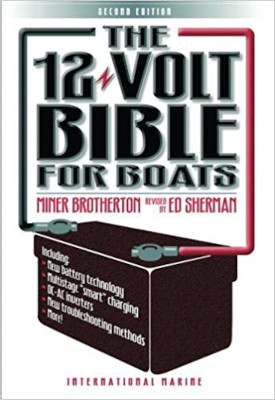 I don’t know about you, but ever since we bought an older cruising sailboat I’ve developed a mild addiction to books about 12-volt electricity. There are many books available on the subject, but so far it’s been hard to find one that wasn’t either too complex, too simple, too theoretical, or simply outdated.
I don’t know about you, but ever since we bought an older cruising sailboat I’ve developed a mild addiction to books about 12-volt electricity. There are many books available on the subject, but so far it’s been hard to find one that wasn’t either too complex, too simple, too theoretical, or simply outdated.
The 12-Volt Bible for Boats promises to explain a boat’s electrical system so you can understand how your system works and how to maintain it in good condition. It also promises information about how to recognize when you have an electrical problem, how to troubleshoot to locate it, and what tools and techniques you’ll need to fix common electrical system problems. After reading the book, I’d say that it does a good job in delivering what it promises.
One of the more pleasing aspects of the book is the emphasis on keeping things simple. The explanations of the theory of electricity were clear, concise, and (thankfully) covered quickly. The use of “magic triangles” to determine the watts, volts, amps or ohms of a piece of equipment or circuit was a real treat. I’m amazed at how many times a book throws out half a dozen algebraic formulae and expects the reader to commit them to memory. The “magic triangle” method is very simple to use and remember.
The book emphasizes the relationship between the electric gizmos that we cart onboard and our need to generate the power to run them. While it doesn’t suggest going without electricity, it does point out that poorly planned changes and additions to your system may result in far more effort and expense than the intended convenience is worth.
Author Ed Sherman covers the standard topics of battery selection, maintenance and charging, wiring, motors, lights, and electronics. Some subjects are covered in more detail than others, but all are discussed with a focus on practicality. Unlike many books where unlimited wealth is assumed, The 12-Volt Bible for Boats openly leans toward saving your money. The book advocates the simple and less expensive route whenever possible but not to the detriment of safety. One of the best features of the book is the troubleshooting section and the maintenance tips. It’s like having your local boatyard guru at your shoulder.
No book is perfect. The methods of charging and isolating battery banks could have been more detailed, and some of the diagrams could have been bigger. I found it annoying that the author’s name was misspelled on the back cover. But overall, the book was clearly written and useful. By the time I had finished, I was ready to dig out my multimeter and head to the boat.
The 12-Volt Bible for Boats, Second Edition by Miner Brotherton, Revised by Ed Sherman (International Marine/Mcgraw-Hill, 2003; 194 pages)




